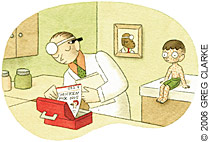
You should start using the updated diagnosis codes Oct. 1.
Fam Pract Manag. 2006;13(8):39-40
Cindy Hughes is the coding and compliance specialist for the AAFP and is a contributing editor to Family Practice Management. Author disclosure: nothing to disclose.

Only coders and a few other special folks anxiously await the annual release of new ICD-9 codes. Even if you’re not one of those excited few, you should be aware of the work that the ICD-9 Coordination and Maintenance Committee has done this year. After all, paying attention to the revised and new codes goes a long way toward ensuring that payers keep paying you.
More specifically…
Many of the new codes were added to let you be more specific when reporting diagnoses. For instance, code 331.83 represents “Mild cognitive impairment, so stated.” This is an improvement over 780.93, “Memory loss,” because it allows for coding cognitive impairment other than memory impairment. Along those same lines, code 780.97 has been added for reporting altered mental status.
Certain types of pain are also more clearly defined with new ICD-9 codes. They include the following:
338.0 Central pain syndrome,
338.11 Acute pain due to trauma,
338.12 Acute post-thoracotomy pain,
338.18 Other acute postoperative pain,
338.19 Other acute pain,
338.21 Chronic pain due to trauma,
338.22 Chronic post-thoracotomy pain,
338.28 Other chronic postoperative pain,
338.29 Other chronic pain,
338.3 Neoplasm related pain (acute) (chronic),
338.4 Chronic pain syndrome,
780.96 Generalized pain.
Codes for sensorineural hearing loss were revised to show that codes 389.11, 389.12, 389.14 and 389.18 represent bilateral hearing loss. Codes were added to report unilateral sensorineural hearing loss, 389.15, and asymmetrical sensorineural hearing loss, 389.16.
Codes in the 403 and 404 categories for reporting hypertensive kidney disease as well as hypertensive heart and kidney disease were revised to align with last year’s changes in the 585 category. The descriptors now include the word “chronic” before “kidney disease.” The fifth-digit choices now align with the stages of chronic kidney disease.
Code 478.1, “Other diseases of nasal cavity and sinuses,” is no longer valid. This category has been expanded to include code 478.11, “Nasal mucositis (ulcerative),” and 478.19, “Other disease of nasal cavity and sinuses.”
Similarly, code 519.1, “Other diseases of trachea and bronchus, not elsewhere classified,” is no longer valid. This category has also been expanded to include 519.11, “Acute bronchospasm,” and 519.19, “Other diseases of trachea and bronchus.”
Several codes in the 600 category related to hypertrophy of the prostate have been revised.
Code 608.2, “Torsion of testis,” is no longer valid due, again, to expansion of the category. Fifth digits 0–4 now provide unique codes for different torsion of the testis conditions previously reported with 608.2.
Codes in the category “Other disorders of female genital tract” have also been expanded. Code 616.8 is no longer valid. See codes 616.81, “Mucositis (ulcerative) of cervix, vagina and vulva,” and 616.89, “Other inflammatory diseases of cervix, vagina and vulva.” Code 618.84 has been added to report cervical stump prolapse. Category 629 has also been expanded to add 629.29, “Other female genital mutilation status;” 629.81, “Habitual aborter without current pregnancy;” and 629.89,“ Other specified disorders of female genital organs.” Code 629.8 is no longer valid.
If you provide obstetrical care, then pay attention to the new category 649 codes. Codes were added for reporting complications of pregnancy due to tobacco-use disorder, obesity, bariatric surgery status, coagulation defects, epilepsy or spotting. Codes were also added in the 649.60–649.64 series that indicate uterine size/date discrepancy.
Definition, please
Several symptoms are better defined. Code 780.31, “Febrile convulsions,” was revised to “Febrile convulsions (simple), unspecified.” Code 780.32 was added for “Complex febrile convulsions.” Code 780.95 was revised to “Excessive crying of child, adolescent or adult.” (Note: Code 780.92 should be reported for excessive crying of an infant.) Code 784.9 has been replaced with more specific codes: 784.91 for “Nasal drip” and 784.99 for “Other symptoms involving head and neck.” In the “Other abnormality of urination” category, you’ll find codes 788.64 for urinary hesitancy and 788.65 for straining on urination.
Reporting of nonspecific abnormal findings may also be easier in some instances. For instance, you can indicate that an imaging study was inconclusive due to excess body fat with code 793.91.
A gap has been filled in the 795.0 category with the addition of code 795.06 for reporting “Pap smear of cervix with cytologic evidence of malignancy.”
New history codes of interest include:
V18.51 Family history, colonic polyps,
V45.86 Bariatric surgery status,
V58.30 Encounter for change or removal of nonsurgical wound dressing,
V58.31 Encounter for change or removal of surgical wound dressing,
V58.32 Encounter for removal of sutures,
V85.51–V85.54 for indexing the body mass of pediatric patients.
There you have it. A lot of little changes designed to make reporting diagnoses a little easier and a little more specific. With a quick update to your superbill, you’ll be ready for another year. Hope it is a good one.
ICD-9 CODING TOOLS
FPM’s ICD-9 coding references have been updated and expanded to comply with the ICD-9 codes that take effect Oct. 1.
The long and short lists
You’ll find updated versions of both “ICD-9 Codes for Family Medicine: The Long List” and “ICD-9 Codes for Family Medicine: The Short List” at https://www.aafp.org/fpm/icd9.html. The lists were developed by Allen Daugird, MD, MBA, Donald Spencer, MD, MBA, and Philip S. Whitecar, MD.
The FPM ICD-9 Reference for PDA
You’ll also find an easy-to-search database of ICD-9 codes for use with personal digital assistants (PDAs) at https://www.aafp.org/fpm/icd9.html. The PDA reference was adapted from FPM’s “Long List” by Robert M. Wolfe, MD, who will demonstrate it at the AAFP Scientific Assembly in Washington. So bring your PDA to DC, and stop by Technology Central on Thursday, Sept. 28, at 2:15 p.m. to see the program in action.